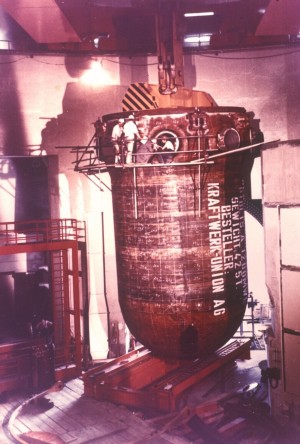ENSI follows WENRA recommendation on review of reactor pressure vessels
The Swiss nuclear power plants (NPP) Beznau and Gösgen are required to perform standardized safety reviews of the base materials in their reactor pressure vessels to check for possible manufacturing flaws. Through this requirement, the Swiss Federal Nuclear Safety Inspectorate ENSI is implementing a recommendation issued by the Western European Nuclear Regulators Association (WENRA).

The ultrasonic inspections shall be carried out within the coming three years, during the next scheduled inspection of the weld seams of the reactor pressure vessels. “We want to make sure that any possibility of hydrogen-induced flaws in the base materials in the reactor pressure vessel can be excluded” says Georg Schwarz, ENSI Deputy Director and Director of the NPP Division for the inspection of nuclear power plants. Inclusions of hydrogen in the base materials can occur during the forging process of the steel.
Already in January 2013, one year before the WENRA recommendation, ENSI required information from Beznau and Gösgen NPPs about the manufacturing, base materials and tests of the reactor pressure vessel forgings. The documents have already been submitted by Gösgen NPP. The documents from Beznau NPP must be presented to ENSI by the end of September 2013.
Flaw indications in Belgium no safety issue
In summer 2012, numerous flaw indications were detected in the base materials of the reactor pressure vessels in the Belgian NPPs Doel 3 and Tihange-2. After careful examination of the flaw indications, the Belgian Regulatory Body (Federaal Agentschap voor Nucleaire Controle FANC) concluded in the spring of 2013 that, in their view, continued operation of the two plants was possible.
WENRA has worked intensively with the flaw indications in Belgium. “Even if the exhaustive inspections of the reactor pressure vessels in the Belgian NPPs Doel-3 and Tinge-2 showed that last year’s findings did not pose any safety threat, we believe that a review of the pressure vessels in all European nuclear power plants is important and necessary” explains Hans Wanner, WENRA Chairman and Director General of ENSI. WENRA has therefore elaborated this recommendation.
Nuclear powerplants Mühleberg and Leibstadt already cleared
In response to the first reports from Belgium, NPPs Mühleberg and Leibstadt were required in August 2012 to submit information on manufacturing, base materials and review records of their reactor pressure vessels. NPP Mühleberg, featuring a forged pressure vessel ring, aditionally performed an ultrasound examination of the base materials. ENSI’s analyses of the test results confirmed that the base materials of the reactor pressure vessel complied with the quality requirements for new reactors. The ultrasonic inspection did not reveal any flaw indications as in the Belgian NPP Doel-3.
The examinations of the flaw indications in Doel 3 and Tihange-2 are of less importance for the reactor pressure vessel in NPP Leibstadt. Although NPP Leibstadt was on the list published by the Belgian regulatory body, it differs from the Belgian reactors, both with respect to manufacturer and the manufacturing process. The material used for the cylindrical shell rings, the domed base and the lid of the reactor pressure vessel was rolled and not forged.

